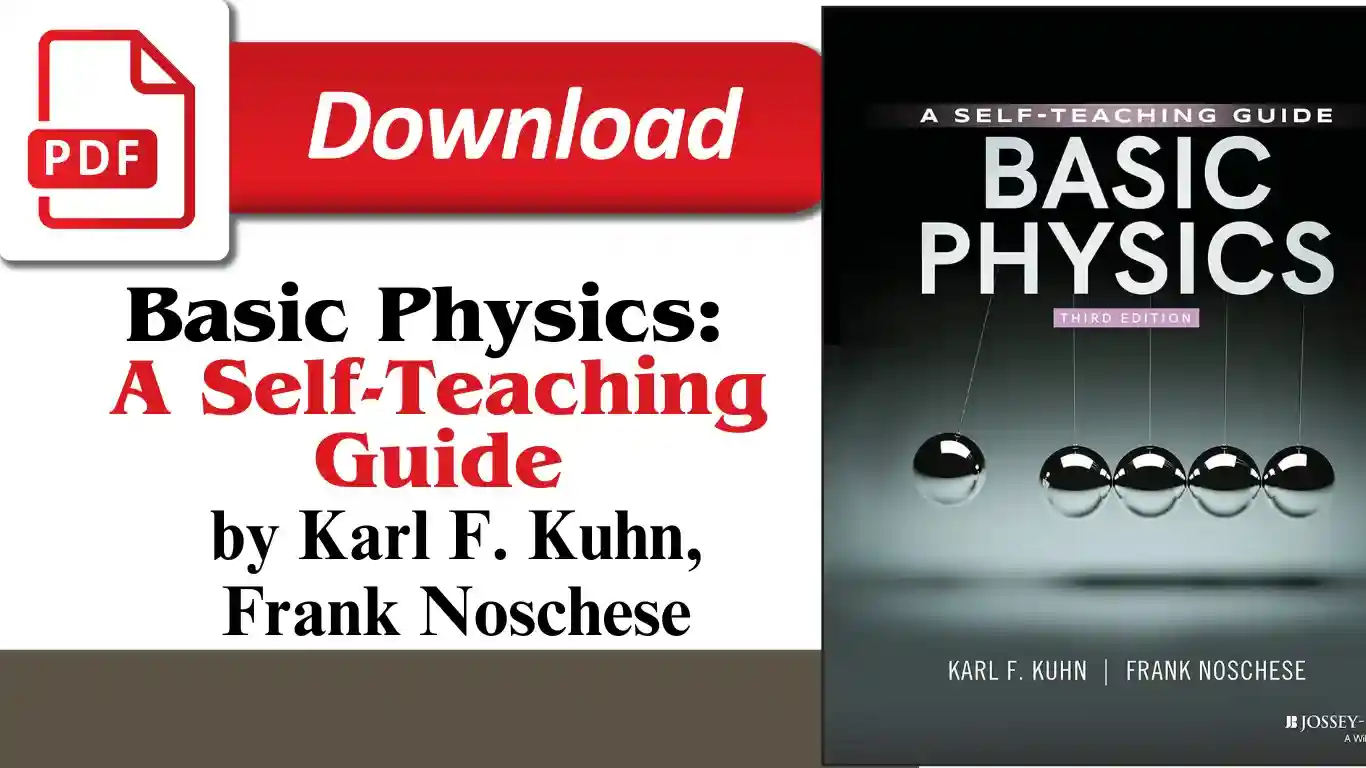Are you trying to improve your knowledge of physics ideas outside of the classroom? We have the ideal book for you! This third edition of Basic Physics: A Self-Teaching Guide is the ideal tool for learning the principles of physics at your own pace. This post will discuss the key components of the book and provide instructions for downloading Basic Physics in PDF format for free from SAVE PDF.
About Basic Physics: A Self-Teaching Guide, 3rd Edition
This thorough tutorial offers a useful, approachable method for comprehending fundamental physics ideas. For self-learners, the book’s easy-to-digest explanations of physics’ complicated concepts are ideal. Regardless of your educational background—high school, college, or just brushing up on your physics knowledge—this guide will assist you in understanding key concepts and ideas in physics.
Concepts Covered – Physics: A Self-Teaching Guide
Chapter 1: Introduction to Physics
This chapter provides an overview of the fundamentals of physics, outlining its purpose and motivating factors for study. Basic ideas like matter, energy, and the scientific process are also covered. You will discover the practical applications of physics as well as its connections to other scientific domains.
Chapter 2: Units and Measurement
Precise measurement is crucial to physics. The significance of units, the metric system, and how to measure physical quantities are all covered in this chapter. Subjects covered include time, mass, length, and unit conversion.
Chapter 3: Motion and Newton’s Laws of Motion
The concepts of acceleration, velocity, and motion are introduced in this chapter. Additionally, Newton’s Three Laws of Motion are covered.
- First Law: The law of inertia
- Second Law: Force equals mass times acceleration (F = ma)
- Third Law: For every action, there is an equal and opposite reaction
Examples and exercises help you apply these principles to real-world situations.
Chapter 4: Energy
This section will examine several types of energy, including as potential and kinetic energy, as well as the energy conservation law. It uses commonplace examples, such as autos and roller coasters, to illustrate how energy is transmitted and transformed across forms.
Chapter 5: Work and Power
This chapter provides a physical definition of power and work. You will discover how to compute the amount of work completed on an item and how power is related to the speed at which work is completed. We introduce equations such as Power = Work ÷ Time and Work = Force × Distance.
Chapter 6: Momentum
This chapter goes into great detail on the idea of momentum, which is the amount of motion that an item has. Impulse, collisions, and momentum conservation are among the subjects covered. It describes momentum’s properties and applications to common physics.
Chapter 7: Rotational Motion and Torque
You will study the mechanics of rotating objects in this chapter. The force that rotates an item is introduced as the idea of torque. Topics covered include rotational energy, angular momentum, and angular velocity.
Chapter 8: Gravity
The force of gravity is examined in this chapter, along with how it affects the motion of planets, stars, and galaxies. Additionally, you will study the Earth’s gravitational field and how the attraction between two objects is explained by Newton’s Law of Universal Gravitation.
Chapter 9: Properties of Matter
This section covers the physical characteristics of matter, such as its mass, volume, density, and states. The chapter presents the idea of pressure and describes how substances transition between their many states—solid, liquid, and gas.
Chapter 10: Heat and Temperature
This chapter examines the differences between temperature and heat as well as the transmission of thermal energy by radiation, convection, and conduction. The rules of thermodynamics and specific heat capacity are also covered.
Chapter 11: Waves and Sound
This chapter examines the mechanical and electromagnetic aspects of waves, of which sound is one type. You’ll discover how wave characteristics—like wavelength, frequency, and amplitude—relate to sound.
Chapter 12: Light and Optics
The characteristics and behavior of light are the main topics of this chapter. The subjects covered are lenses, diffraction, reflection, and refraction. The electromagnetic spectrum, which includes visible light, ultraviolet light, and infrared light, will also be covered.
Chapter 13: Electricity and Magnetism
This article explains electricity and magnetism, including how magnetic fields are produced by electric currents and vice versa. Ohm’s Law, electric circuits, electromagnets, and the interaction of electricity and magnetism in motors and generators are among the subjects covered.
Chapter 14: Atomic and Nuclear Physics
Protons, neutrons, and electrons are the topics covered in this chapter’s exploration of the atomic structure. As an introduction to nuclear energy, it also looks at radioactivity, nuclear processes, fission, and fusion.
Chapter 15: Relativity and Quantum Physics
Albert Einstein’s theory of relativity and quantum mechanics are introduced in the last chapter. It provides an overview of contemporary physics by discussing how time and space are relative to the observer and how atoms and subatomic particles behave.
With the objectives, test questions, and exercises clearly laid out in each chapter, it’s simple to keep track of your progress and expand your knowledge of the material. Physics instruction becomes adaptable and interesting thanks to the interactive style of the book.
Why Choose Basic Physics?
This self-study manual is ideal for anyone wishing to learn physics on their own. It makes use of contemporary research-based techniques to guarantee that you can swiftly and efficiently grasp fresh information. In comparison to earlier editions, the third edition offers a more adaptable and dynamic learning environment since it has been updated with the most recent techniques and explanations.
Download Basic Physics: A Self-Teaching Guide PDF Now!
Searching for the PDF of Basic Physics? Here at SAVE PDF, we provide a comprehensive library of learning materials, including physics books, study guides, and study materials, for you to download. To obtain your copy, just click the link provided below.
File Type: PDF

